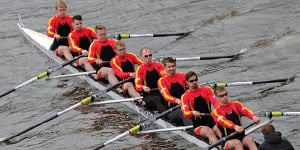It is generally accepted that crew coordination is of utmost importance and that rowers need to work in perfect synchronization to maximize the speed of the boat.

However, there has been discussion that out-of-phase (antiphase) rowing might be faster than in-phase (synchronous) rowing, as in synchronous rowing 5-6% of the power produced is lost to velocity fluctuations of the shell within each rowing cycle.
Brouwer et al. (2013) carried out an investigation with nine pairs of club level male rowers who performed a two-minute maximum effort synchronous and antiphase rowing at 36 strokes per minute. Two coupled free-floating ergometers (Concept II slides) were used that allowed power losses to velocity fluctuations. All nine pairs easily managed rowing in antiphase coordination within the five-minute warm-up.
Antiphase interpersonal coordination was shown to be less accurate and stable but it did not cause any power loss. Furthermore, the decreased power loss to velocity fluctuations resulted in more power being transferred to ergometer flywheels. The widely used synchronous coordination might be more stable but not necessarily more efficient in terms of speed. As the study was conducted using rowing ergometers, further on-water research might be needed to enlighten this matter.
What to learn from this?
Synchronous coordination is more stable and accurate than antiphase, but the velocity fluctuations of the shell cause a power loss during each rowing cycle. Antiphase coordination enables the rowers to utilize more of their energy put into strokes and therefore also into boat speed. However, the latter needs more testing on water.
| Table. Rowing performance in terms of mechanical power, velocity efficiency and interpersonal coordination (mean ± SD), paired t-test statistics (n = 8, df = 7) | ||||
| In-phase | Antiphase | t | p | |
| SR (min-1) | 36.5 ± 0.5 | 35.3 ± 0.6 | 3.864 | < 0.01 |
| Prowers (W) | 731 ± 73 | 740 ± 80 | 0.723 | 0.493 |
| Pflywheels (W) | -690 ± 66 | -734 ± 81 | 3.349 | < 0.05 |
| ev | 0.945 ± 0.013 | 0.991 ± 0.004 | 11.167 | < 0.001 |
| sergometers (m) | 0.96 ± 0.11 | 0.33 ± 0.06 | 12.180 | < 0.001 |
| AEϕ (°) | 7 ± 1 | 24 ± 5 | 11.001 | < 0.001 |
| SDϕPE (°) | 4 ± 2 | 12 ± 6 | 3.340 | < 0.05 |
| Ratio | 1: 1.2 ± 0.1 | 1: 1.2 ± 0.1 | 1.528 | 0.170 |
| de Bouwer et al. 2013 | ||||
Source
de Brouwer AJ, de Poel HJ, Hofmijster MJ. Don’t Rock the Boat: How Antiphase Crew Coordination Affects Rowing. PLoS ONE 2013; 8(1): e54996.